
King Henry VII Costume - 1485-1509 English Costume by Dion Clayton Calthrop
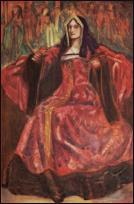
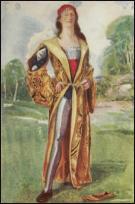 This Tudor costume history information consists of Pages 223-247 of the chapter on the late 15th and early 16th century dress in the 24 YEAR REIGN era of Henry the Seventh 1485-1509 and taken from English Costume by Dion Clayton Calthrop.
This Tudor costume history information consists of Pages 223-247 of the chapter on the late 15th and early 16th century dress in the 24 YEAR REIGN era of Henry the Seventh 1485-1509 and taken from English Costume by Dion Clayton Calthrop.
KING HENRY THE SEVENTH - Reigned 24 years: 1485-1509. Born, 1456. Married, 1486, Elizabeth of York.
THE MEN
Everyone has felt that curious faint aroma, that sensation of lifting, which proclaims the first day of Spring and the burial of Winter. Although nothing tangible has taken place, there is in the atmosphere a full-charged suggestion of promise, of green-sickness; there is a quickening of the pulse, a thrumming of the heart, and many an eager, quick glance around for the first buds of the new order of things.
England's winter was buried on Bosworth Field: England's spring, as if by magic, commenced with Henry's entry into London.
The first picture of the reign shows the mayor, the sheriffs, and the aldermen, clothed in violet, waiting at Shoreditch for the coming of the victor. The same day shows Henry in St. Paul's, hearing a Te Deum; in the Cathedral church, packed to its limit, three new banners waved, one bearing a figure of St. George, another a dragon of red on white and green sarcenet, and the third showed a dun cow on yellow tarterne.
Spring, of course, does not, except in a poetic sense, burst forth in a day, there are long months of preparation, hints, signs in the air, new notes from the throats of birds.
The springtime of a country takes more than the preparation of months. Nine years before Henry came to the throne Caxton was learning to print in the little room of Collard Mansion - he was to print his 'Facts of Arms,' joyous tales and pleasant histories of chivalry, by especial desire of Henry himself.
Later still, towards the end of the reign, the first book of travel in the West began to go from hand to hand - it was written by Amerigo Vespucci, cousin to La Bella Simonetta.
Great thoughts were abroad, new ideas were constantly under discussion, the Arts rose to the occasion and put forth flowers of beauty on many stems long supposed to be dead or dormant and incapable of improvement. It was the great age of individual English expression in every form but that of literature and painting, both these arts being but in their cradles; Chaucer and Gower and Langland had written, but they lay in their graves long before new great minds arose.
The Fashions of 1485
The clouds of the Middle Ages were dispersed, and the sun shone. The costume was at once dignified and magnificent - not that one can call the little coats great ideals of dignity, but even they, by their richness and by the splendour of the persons they adorned, come into the category. The long gowns of both men and women were rich beyond words in colour, texture, and design, they were imposing, exact, and gorgeous. Upon a fine day the streets must have glittered when a gentleman or lady passed by. The fashions of the time have survived for us in the Court cards: take the jacks, knaves, valets - call them as you will, and you will see the costume of this reign but slightly modified into a design, the cards of to-day and the cards of that day are almost identical. Some years ago the modification was less noticeable; I can remember playing Pope Joan with cards printed with full-length figures, just as the illustrations to 'Alice in Wonderland' are drawn. In the knave you will see the peculiar square hat which came in at this time, and the petti-cote, the long coat, the big sleeve, and the broad-toed shoes.Hair and Headwear 1485
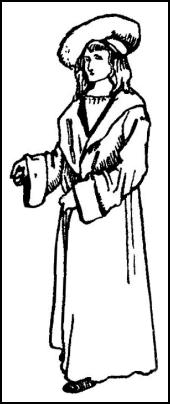
You will see the long hair, undressed and flowing over the shoulders (the professional classes, as the lawyer, cut their hair close, so also did the peasant).
The Little Cap
Over this flowing hair a dandy would wear a little cap with a narrow, rolled-up brim, and over this, on occasions, an enormous hat of felt, ornamented with a prodigious quantity of feathers.The Berretino
There was, indeed, quite a choice of hats: the berretino - a square hat pinched in at the corners; many round hats, some with a high, tight brim, some with the least brim possible; into these brims, or into a band round the hat, one might stick feathers or pin a brooch.Early Tudor Era Coats
What a choice of coats the gentlemen had, and still might be in the fashionThe Dressing Gown Coat Fashion
Most common among these was the long coat like a dressing-gown, hanging upon the ground all round, with a wide collar, square behind, and turning back in the front down to the waist - this was the general shape of the collar, and you may vary it on this idea in every way: turn it back and show the stuff to the feet, close it up nearly to the neck, cut it off completely.The Wide Sleeves

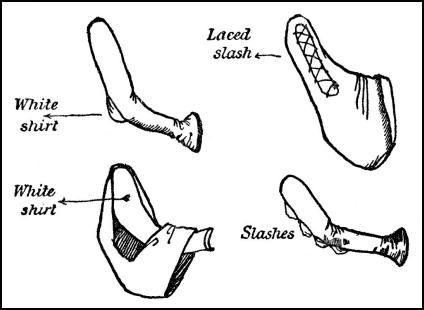
The Shirt
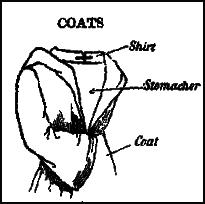
 The shirt itself was often ornamented with fine gathers and fancy stitching, and was gathered about the neck by a ribbon. As the years went on it is easy to see that the shirt was worn nearer to the neck, the gathers became higher and higher, became more ornamented, and finally rose, in all extravagant finery, to behind the ears - and we have the Elizabethan ruff.
The shirt itself was often ornamented with fine gathers and fancy stitching, and was gathered about the neck by a ribbon. As the years went on it is easy to see that the shirt was worn nearer to the neck, the gathers became higher and higher, became more ornamented, and finally rose, in all extravagant finery, to behind the ears - and we have the Elizabethan ruff.
Waistcoat Or Stomacher
Next to the shirt a waistcoat, or stomacher, of the most gorgeous patterned stuff, laced across the breast sometimes, more often fastened behind. This reached to the waist where it met long hose of every scheme of colour - striped, dotted, divided in bands - everything - displaying the indelicate but universal pouch in front, tied with coloured ribbons.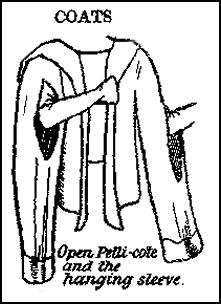 On the feet, shoes of all materials, from cloth and velvet to leather beautifully worked, and of the most absurd length; these also were slashed with puffs of white stuff. Many of these shoes were but a sole and a toe, and were tied on by thongs passing through the sole.
On the feet, shoes of all materials, from cloth and velvet to leather beautifully worked, and of the most absurd length; these also were slashed with puffs of white stuff. Many of these shoes were but a sole and a toe, and were tied on by thongs passing through the sole.
Short Jacket Or Petti-Cote
Of course the long coat would not alone satisfy the dandy, but he must needs cut it off into a short jacket, or petti-cote, and leave it open to better display his marvellous vest. Here we have the origin of the use of the word 'petticoat' - now wrongly applied; in Scotland, to this day, a woman's skirts are called her 'coats.' About the waists of these coats was a short sash, or a girdle, from which hung a very elaborate purse, or a dagger. Stick in hand, jewel in your hat, dandy - extravagant, exquisite dandy!All ages know you, from the day you choose your covering of leaves with care, to the hour of your white duck motoring-suit: a very bird of a man, rejoicing in your plumage, a very human ass, a very narrow individual, you stride, strut, simper through the story of the universe, a perfect monument of the Fall of Man, a gorgeous symbol of the decay of manhood. 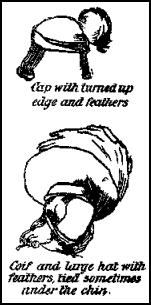
A Man's Hairstyle
In this our Henry's reign, your hair busheth pleasantly, and is kembed prettily over the ear, where it glimmers as gold i' the sun - pretty fellow - Lord! how your feathered bonnet becomes you, and your satin stomacher is brave over a padded chest. Your white hands, freed from any nasty brawls and clean of any form of work, lie in their embroidered gloves. Your pride forbids the carriage of a sword, which is borne behind you - much use may it be! - by a mincing fellow in your dainty livery. And if - oh, rare disguise! - your coiffure hides a noble brow, or your little, neat-rimmed coif a clever head, less honour be to you who dress your limbs to imitate the peacock, and hide your mind beneath the weight of scented clothes.Calthrop's Guide To Illustrations
In the illustrations to this chapter and the next, my drawings are collected and redrawn in my scheme from works so beautiful and highly finished that every student should go to see them for himself at the British Museum. My drawings, I hope, make it quite clear what was worn in the end of the fifteenth century and the first nine years of the sixteenth, and anyone with a slight knowledge of pictures will be able to supply themselves with a large amount of extra matter. I would recommend MS. Roy 16, F. 2; MS. Roy 19, C. 8; and especially Harleian MS. 4425.Poor Lower Classes - Peasants, Beggars
Of the lower classes, also, these books show quite a number. There are beggars and peasants, whose dress was simply old-fashioned and very plain; they wore the broad shoes and leather belts and short coats, worsted hose, and cloaks of fair cloth. 'Poverty,' the old woman with the spoon in her hat, is a good example of the poor of the time.A MAN OF THE TIME OF HENRY VII - 1485-1509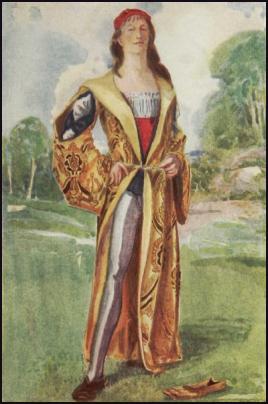
This costume plate shows the long coat fashion and made up in lavish material or as it was known 'good stuff'. The chaperon, described in earlier chapters was still worn by Garter Knights at times. other official, legal, civic, and college persons also wore it as their hat of choice.
Stuffs of Silk - Materials Used in Tudor Era
When one knows the wealth of material of the time, and has seen the wonder of the stuffs, one knows that within certain lines imagination may have full scope. Stuffs of silk, embroidered with coupled birds and branches, and flowers following out a prescribed line, the embroideries edged and sewn with gold thread; velvet on velvet, short-napped fustian, damasked stuffs and diapered stuffs - what pictures on canvas, or on the stage, may be made; what marvels of colour walked about the streets in those days! It was to the eye an age of elaborate patterns - mostly large - and all this broken colour and glitter of gold thread must have made the streets gay indeed.Huntsmen At Corfe Castle
Imagine, shall we say, Corfe Castle on a day when a party of ladies and gentlemen assembled to 'course a stagge,' when the huntsmen, in green, gathered in the outer ward, and the grooms, in fine coloured liveries, held the gaily-decked horses; then, from the walls lined with archers, would come the blast of the horn, and out would walk my lord and my lady, with knights, and squires, and ladies, and gallants, over the bridge across the castle ditch, between the round towers. Behind them the dungeon tower, and the great gray mass of the keep - all a fitting and impressive background to their bravery.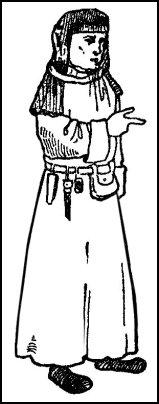
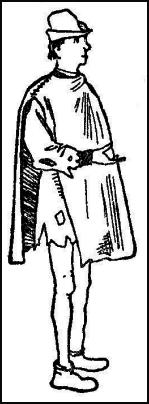
Merchants, Beggars & Pilgrims
Below, in the town over the moat, a crowd is gathered to see them off - merchants in grave colours, and coats turned back with fur, their ink-horns slung at their waists, with pens and dagger and purse; beggars; pilgrims, from over seas, landed at Poole Harbour, in long gowns, worn with penitence and dusty travels, shells in their hats, staffs in their hands; wide-eyed children in smocks; butchers in blue; men of all guilds and women of all classes. The drawbridge is down, the portcullis up, and the party, gleaming like a bed of flowers in their multi-coloured robes, pass over the bridge, through the town, and into the valley. The sun goes in and leaves the grim castle, gray and solemn, standing out against the green of the hills....King Henry VII
And of Henry himself, the great Tudor, greater, more farseeing than the eighth Henry, a man who so dominates the age, and fills it with his spirit, that no mental picture is complete without him. His fine, humorous face, the quizzical eye, the firm mouth, showing his character. The great lover of art, of English art, soon to be pulverized by pseudo-classic influences; the man who pulled down the chapel at the west end of Westminster Abbey with the house by it - Chaucer's house - to make way for that superb triumph of ornate building, his chapel, beside which the mathematical squares and angles of classic buildings show as would boxes of bricks by a gorgeous flower. The stories against him are, in reality, stories for him, invented by those whom he kept to their work, and whom he despoiled of their ill-gotten gains. He borrowed, but he paid back in full; he came into a disordered, distressed kingdom, ruled it by fear - as had to be done in those days - and left it a kingdom ready for the fruits of his ordered works - to the fleshy beast who so nearly ruined the country. What remained, indeed, was the result of his father's genius.THE WOMEN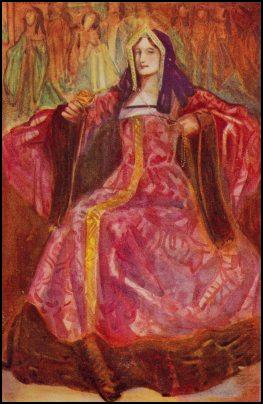
Take up a pack of cards and look at the queen. You may see the extraordinary head-gear as worn by ladies at the end of the fifteenth century and in the first years of the sixteenth, worn in a modified form all through the next reign, after which that description of head-dress vanished for ever, its place to be taken by caps, hats, and bonnets.
A WOMAN OF THE TIME OF HENRY VII - 1485-1509
This is a sumptuous gown in rich elaborate material - good stuff - not any old fabric. Notice the diamond-shaped head-dress, the wide, fur-edged gown with its full sleeves.Early Tudor Caps, Bonnets, Hats, Headdresses, Coifs
The richest of these head-dresses were made of a black silk or some such black material, the top stiffened to the shape of a sloping house-roof, the edges falling by the face on either side - made stiff, so as to stand parallel - these were sewn with gold and pearls on colour or white. The end of the hood hung over the shoulders and down the back; this was surmounted by a stole of stiffened material, also richly sewn with jewels, and the whole pinned on to a close-fitting cap of a different colour, the edge of which showed above the forehead. The more moderate head-dress was of black again, but in shape nearly square, and slit at the sides to enable it to hang more easily over the shoulders. It was placed over a coif, often of white linen or of black material, was turned over from the forehead, folded, and pinned back; often it was edged with gold.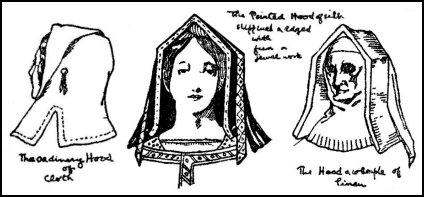
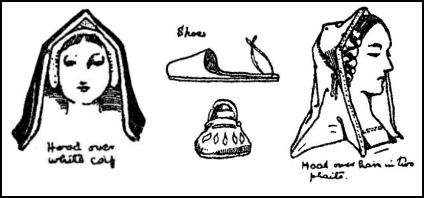
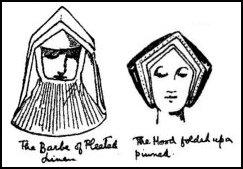
Womens Gowns - Early Tudor 1485-1509
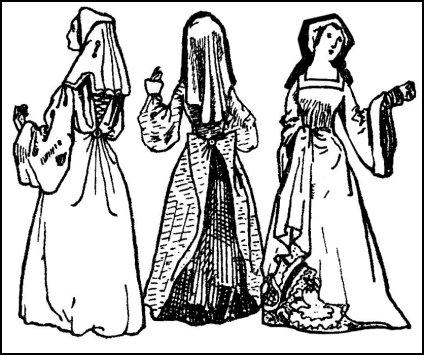 The gowns of the women were very simply cut, having either a long train or no train at all, these last cut to show the under-skirt of some fine material, the bodice of which showed above the over gown at the shoulders.
The gowns of the women were very simply cut, having either a long train or no train at all, these last cut to show the under-skirt of some fine material, the bodice of which showed above the over gown at the shoulders.
The Early Tudor Gown Bodice
The bodice of the gown was square cut and not very low, having an ornamental border of fur, embroidery, or other rich coloured material sewn on to it. This border went sometimes round the shoulders and down the front of the dress to below the knees. Above the bodice was nearly always seen the V-shaped opening of the under petticoat bodice, and across and above that, the white embroidered or crimped chemise.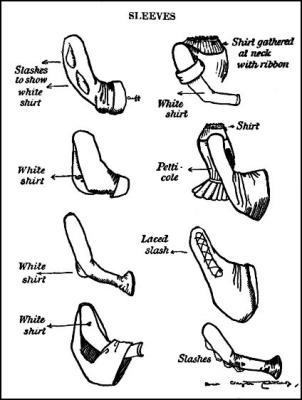 The Women's Sleeves
The Women's Sleeves
The sleeves were as the men's - tight all the way down from the shoulder to the wrist, the cuffs coming well over the first joints of the fingers (sometimes these cuffs are turned back to show elaborate linings), or they were made tight at the shoulder and gradually looser until they became very full over the lower arm, edged or lined with fur or soft silk, or loose and baggy all the way from shoulder to hand.
Bruges Damask Silks
At this time Bruges became world-famed for her silken texture; her satins were used in England for church garments and other clothes. The damask silks were greatly in use, and were nearly always covered with the peculiar semi-Spanish pattern, the base of which was some contortion of the pomegranate. Some of these patterns were small and wonderfully fine, depending on their wealth of detail for their magnificent appearance, others were huge, so that but few repeats of the design appeared on the dress.Late C15th Block Printed Linens
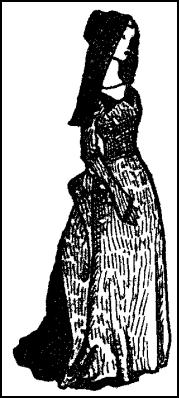 Block-printed linens were also in use, and the samples in South Kensington will show how beautiful and artistic they were, for all their simple design.
Block-printed linens were also in use, and the samples in South Kensington will show how beautiful and artistic they were, for all their simple design.
Bruges Lace Making
To-day one may see in Bruges the women at the cottage doors busy over their lace-making, and the English women by the sea making nets - so in those times was every woman at her cottage door making coarse linens and other stuffs to earn her daily bread, while my lady was sitting in her chamber weaving, or embroidering a bearing cloth for her child against her time. However, the years of the Wars of the Roses had had their effect on every kind of English work, and as the most elegant books were painted and written by Flemings, as the finest linen came from Yprès, the best silks and velvets from Bruges, the great masters of painting from Florence, Germany, and Belgium, so also the elaborate and wonderful embroidery, for which we had been so famous, died away, and English work was but coarse at the best, until, in the early sixteen hundreds, the new style came into use of raising figures some height above the ground-work of the design, and the rich embroidery of the Stuart times revived this art.Jewel Laden Dresses & Stomachers
I have shown that this age was the age of fine patterns, as some ages are ages of quaint cut, and some of jewel-laden dresses, and some of dainty needlework. A few ladies wore their gowns open to the waist to show the stomacher, as the men did, and open behind to the waist, laced across, the waist being embraced by a girdle of the shape so long in use, with long ends and metal ornaments; the girdle held the purse of the lady. The illustrations given with this chapter show very completely the costume of this time, and, except in cases of royal persons or very gorgeously apparelled ladies, they are complete enough to need no description.Early Tudor Shoes
The shoes, it will be seen, are very broad at the toes, with thick soles, sometimes made much in the manner of sandals - that is, with only a toecap, the rest flat, to be tied on by strings.Making An Early Tudor Dress For Dramatic & Shakespearean Stage Plays Costuming
As this work is entirely for use, it may be said, that artists who have costumes made for them, and costumiers who make for the stage, hardly ever allow enough material for the gowns worn by men and women in this and other reigns, where the heaviness and richness of the folds was the great keynote. To make a gown, of such a kind as these good ladies wore, one needs, at least, twelve yards of material, fifty-two inches wide, to give the right appearance. It is possible to acquire at many of the best shops nowadays actual copies of embroidered stuffs, velvets, and damask silks of this time, and of stuffs up to Early Victorian patterns, and this makes it easy for painters to procure what, in other days, they were forced to invent. Many artists have their costumes made of Bolton sheeting, on to which they stencil the patterns they wish to use - this is not a bad thing to do, as sheeting is not dear and it falls into beautiful folds. The older ladies and widows of this time nearly all dressed in very simple, almost conventual garments, many of them wearing the 'barbe' of pleated linen, which covered the lower part of the face and the chin - a sort of linen beard - it reached to the breast, and is still worn by some religious orders of women.Badges
Badges were still much in use, and the servants always wore some form of badge on their left sleeve - either merely the colours of their masters, or a small silver, or other metal, shield. Thus, the badge worn by the servants of Henry VII would be either a greyhound, a crowned hawthorn bush, a red dragon, a portcullis, or the red and white roses joined together.Tudor Roses
The last two were used by all the Tudors, and the red rose and the portcullis are still used. From these badges we get the signs of many of our inns, either started by servants, who used their master's badge for a device, or because the inn lay on a certain property the lord of which carried chequers, or a red dragon, or a tiger's head.Italian Velvets From Florence
I mentioned the silks of Bruges and her velvets without giving enough prominence to the fine velvets of Florence, a sample of which, a cope, once used in Westminster Abbey, is preserved at Stonyhurst College; it was left by Henry VII to 'Our Monastery of Westminster,' and is of beautiful design - a gold ground, covered with boughs and leaves raised in soft velvet pile of ruby colour, through which little loops of gold thread appear. I imagine Elizabeth of York, Queen to Henry VII, of the subtle countenance - gentle Elizabeth, who died in child-birth - proceeding through London, from the Tower to Westminster, to her coronation; the streets cleansed and the houses hung with tapestry, arras and gold cloth, the fine-coloured dresses of the crowd, the armoured soldiers, all the rich estate of the company about her, and the fine trappings of the horses. Our Queen went to her coronation with some Italian masts, paper flowers, and some hundreds of thousands of yards of bunting and cheap flags; the people mostly in sombre clothes; the soldiers in ugly red, stiff coats, were the only colour of note passing down Whitehall, past the hideous green stuck with frozen Members of Parliament, to the grand, wonderful Abbey, which has seen so many Queens crowned.
 This Tudor costume history information consists of Pages 223-247 of the chapter on the late 15th and early 16th century dress in the 24 YEAR REIGN era of Henry the Seventh 1485-1509 and taken from English Costume by Dion Clayton Calthrop.
This Tudor costume history information consists of Pages 223-247 of the chapter on the late 15th and early 16th century dress in the 24 YEAR REIGN era of Henry the Seventh 1485-1509 and taken from English Costume by Dion Clayton Calthrop.
NEXT - HENRY THE EIGHTH -1509-1547
Sitemap
- Costume History Home
- Introduction to English Costume by Calthrop
- 1066-1216 Norman
- 1272-1485 Plantagenet
- 1485-1603 Tudor
- 1485-1509 Henry VII
- 1509-1547 Henry VIII Costume
- 1547-1553 Edward VI
- 1553-1558 Mary I
- 1558-1603 Elizabeth I Costume
- 1603-1714 Stuart
- 1603-1830 Hanover
- Chambre Syndicale
- Theories of Fashion